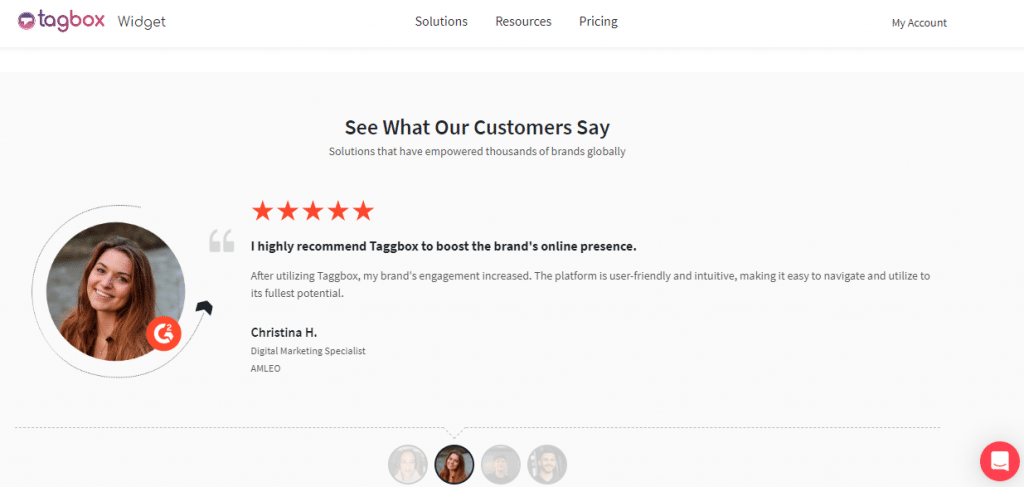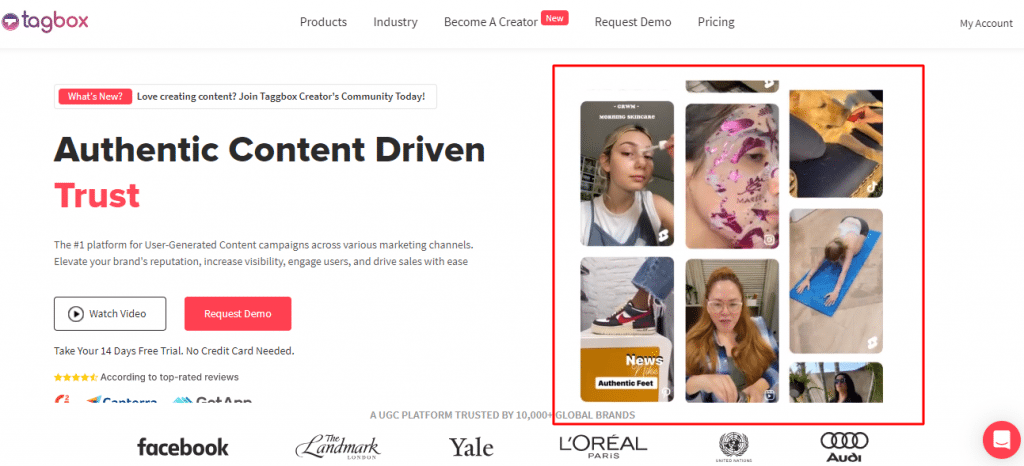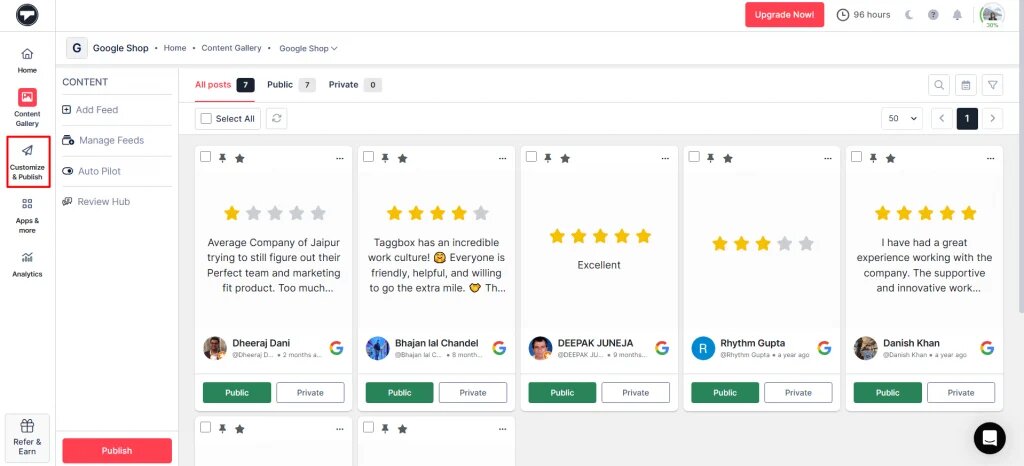Read summarized version with
Testimonials have a huge role to play in building the trust and credibility of a brand among its clients. A well-crafted testimonial on a website not only showcases the positive experiences of customers but also serves as a powerful marketing tool. As businesses strive to enhance their online presence, creating an impactful testimonial page becomes even more essential.
In this guide, we will explore some different examples of testimonial pages on websites, unraveling how to showcase customer feedback. These testimonials serve as beacons of authenticity, influencing potential customers and fostering a sense of reliability.
Embark on this journey as we dissect the strategies employed by successful brands. We have described insights into constructing compelling testimonial pages for your brand website.
Grow your brand on Instagram: Embed Now
| No Credit Card Required |
What Do You Mean by “Testimonial”?
A testimonial is a powerful expression of satisfaction from a client regarding a product or a service. It serves as a firsthand display of a positive experience, providing potential customers with valuable insights into the brands’ quality.
Testimonials often encompass personal anecdotes, specific details about the product or service, and the impact it had on the customer. These endorsements carry a weight of authenticity, as they are reflections of genuine experiences.
As businesses aim to establish trust and credibility, testimonials become integral components of marketing strategies. They act as social proof, influencing potential customers and reinforcing the reputation of a brand. In the digital age, testimonial pages on websites serve as curated collections of these commendations, creating a compelling narrative of satisfied customers.
How to Write a Good Testimonial?
Crafting an impactful testimonial is an art that can significantly contribute to the success of businesses. A well-written testimonial not only shares positive experiences but also resonates with potential customers, fostering trust and credibility. Here are key tips on how to create a compelling testimonial:
- Be Specific: Provide details about your experience, focusing on specific aspects of the product or service that stood out.
- Highlight Results: Share tangible results or outcomes you achieved, emphasizing the positive impact on your life or business.
- Authenticity Matters: Be genuine in your testimonial. Speak from the heart, and let your true feelings and experiences shine through.
- Include Relevant Details: Mention your name, location, and any relevant credentials or affiliations to add authenticity.
- Keep it Concise: While detailing your experience, ensure your testimonial is concise and easy to read, capturing the essence of your satisfaction.
Best Examples of Testimonials on Website
Following are different examples of how brands around the world have placed their testimonial to create maximum impact on the client.
1) Dedicated Page for Testimonials
To maximize the impact of happy customer testimonials on your website, it’s common to feature them on a dedicated testimonial page. This allows you to showcase top endorsements, enticing visitors to become new customers.
Brands can strategically embed Facebook reviews on a separate webpage, seamlessly aligning the feed with their brand’s minimalist design. Achieving visual consistency enhances the brand’s appeal.
Utilizing tools for a dedicated page streamlines the process, enabling you to effortlessly create a Facebook testimonial page. This seamlessly integrates with your website’s design, ensuring a beautiful and branded appearance within minutes.
2) Display on Home Page

Leveraging Facebook testimonials on your website’s homepage is an effective strategy to showcase customer perspectives. It can also make a positive first impression, potentially converting visitors into customers.
This approach not only highlights your brand’s positive reception but also emphasizes an active community. This encourages visitors to connect on social media platforms. For instance, many brands integrate Facebook reviews with their Twitter feed, demonstrating a multi-platform presence.
Additionally, this combination of testimonials and social media content serves as a bonus. This fosters customer engagement through diverse and authentic user experiences.
3) Testimonial on Carousel

A lot of brands effectively utilize their reviews page by featuring a diverse range of testimonials. Notably, they employ a carousel slider showcasing testimonials sourced directly from their special media or review platform.
This dynamic presentation not only provides social proof but also emphasizes positive feedback about their products. Brands use the inclusion of product pages beneath the testimonials to ensure a clear call-to-action (CTA), creating an opportunity to drive more sales.
By combining genuine customer sentiments with a user-friendly layout, this adding testimonial as carousels maximizes the impact of social proof. This offers potential customers a compelling and interactive experience that encourages trust and purchase decisions.
4) Footer with Instagram Image and Testimonials

Brands effectively employ visual customer testimonials, incorporating photos and videos, to engage website visitors and convey genuine customer stories and positive experiences. The brand seamlessly integrates an Instagram feed of user-generated content (UGC) into its website footer.
This curated feed features content from satisfied customers, filtered using the branded hashtag. By showcasing customer reviews of using their products. Potential buyers gain valuable insights into product usage and receive a compelling push toward making a purchase.
5) Video Testimonials Page

Testimonial videos are crucial for converting website visitors, offering a more convincing and emotionally resonant experience compared to written testimonials. By showcasing body language and genuine emotions, these videos provide a deeper connection with potential customers.
Additionally, highlighting use cases for products enhances the practical understanding of their benefits. For added impact, featuring customer success stories in the videos contributes further credibility.
A brand can enjoy several benefits by presenting client testimonials through a video feed, complemented by written descriptions beneath them. This multifaceted strategy effectively engages viewers, instills trust, and encourages conversion.
6) Sidebar
When strategically placing testimonials on your website, consider utilizing the often-overlooked sidebar as an ideal space to showcase them alongside other content. The sidebar proves to be a valuable location to feature testimonials, offering an opportunity to draw visitors’ attention while complementing your overall site layout.
For instance, if you desire a Facebook review feed similar to the example mentioned, some tools enable creation and customization. By displaying reviews from prominent platforms, you not only add variety to your site but also capture people’s attention. This enhances the overall appeal and credibility of your brand.
7) Image Galleries with Testimonials

Visual content is an excellent way to enhance the appeal of your web pages, making them more engaging and inviting. High-quality images not only break up large text blocks, making it easier for people to skim through content, but they also cater to visual learners who find pictures more comprehensible.
Harnessing the power of visual content by showcasing their testimonials in stunning image galleries creates a significant impact. Achieving a similar effect is made simple with testimonial tools like vouch available online. This allows you to choose the type of content for display, to elevate the visual appeal of your website.
8) Display on Contact Page

The contact page is a prime space for potential customers to inquire about products or services. While many websites typically include a company logo, and contact information on this page, you can enhance its utility by incorporating testimonials.
The Chandeliers achieved this by importing testimonials from their Facebook page using a Reviews extension. Notably, they also provide a platform for customers to submit online reviews, facilitating the easy collection of valuable feedback.
9) About Us Page

The About page serves as a crucial space where your target audience gains insights into your business, forming initial impressions. To make this page as informative as possible, it’s essential to incorporate various types of testimonials.
An individual video testimonial takes center stage on the ‘About’ page, seamlessly combining different testimonial formats with essential brand information. This approach not only provides authenticity but also engages visitors on a personal level, creating a compelling narrative about the business.
By integrating video testimonials into the About page, businesses can enhance the overall user experience, fostering trust and connection with their audience.
10) User-Generated Content on Product Page

This example demonstrates a pioneering use of User-Generated Content (UGC) in eCommerce by integrating website testimonials onto high-performance product pages. This strategic approach, facilitated by various tools, contributes to increased conversion rates. Customers are more likely to make purchases when presented with authentic reviews which makes this approach highly effective.
Brands leverage real customer experiences to authenticate their products and build trust among potential buyers. The process is streamlined, as there’s no need for a separate account on platforms like Shopify.
11) Check Out Page
Shopping cart abandonment poses a significant challenge for eCommerce stores, leading to lost sales. Integrating effective testimonials into your checkout page can have a substantial impact on potential customers’ purchase decisions and help reduce cart abandonment.
By featuring social media posts with positive reviews and success stories during the checkout process, you provide tangible proof of your product or service’s value. This added reassurance can serve as the final push needed for customers to commit to making a purchase.
To implement a similar strategy, businesses can use social feed plugins, to filter and display testimonials on their checkout pages. This enhances the overall shopping experience and boosts conversion rates.
12) Quotes
Shopping cart abandonment is a significant challenge for eCommerce, resulting in lost sales. However, integrating impactful testimonials into the checkout page can notably influence potential customers, reducing abandonment rates.
By showcasing social media posts containing positive reviews at the checkout stage, businesses provide tangible proof of their product value. This added reassurance acts as a decisive factor, encouraging customers to finalize their purchase.
To implement a comparable strategy, businesses can leverage social feed plugins like those from Smash Balloon. This allows them to filter and display testimonials seamlessly on the checkout page. This approach enhances the overall shopping experience and contributes to higher conversion rates.
Get inspired by these examples and start to implement them now!
How To Show Testimonial Widget On Your Website?
Want to showcase glowing testimonials on your website, no coding required? Here’s a step-by-step guide to make it happen in seconds:
1) Sign up for Tagembed or log in if you have an existing account:

2) Now, select any review platform, for example you can choose “Google Review” to show google reviews on website.

3) Select any connection type from “Places” or “My Places“. Connect your Google business account or type the address to add reviews. Then click on “Create Feed“

You will be redirected to a window where your Google review widget is created. You can moderate your review gallery by filtering out any irrelevant content from the feed.
4) Now, click on “Customize & Publish” from the sidebar and next select website as your channel.

5) Here you can customize your review gallery, after customization click on “Generate Code“

6) Select any CMS platform where you want to add the Google Review Gallery, copy the embed code and paste it on the website’s backend.

Yay!! Your Google Reviews Gallery is created and added successfully to your website.
Conclusion
Testimonials stand as pillars of authenticity and credibility. As we’ve explored the intricacies of what testimonials mean and how to craft impactful ones, it’s evident that these expressions of satisfaction hold immense potential for businesses. From being specific and highlighting results to embracing authenticity and conciseness, the art of writing a good testimonial involves a careful blend of sincerity and strategic communication.
As businesses embrace the power of testimonials on their websites, they embark on a journey of building connections with their audience. A well-curated testimonial page serves not only as a showcase of positive experiences but also as a testament to the reliability. Through the words of satisfied customers, businesses can forge relationships and inspire trust in the ever-evolving landscape.










